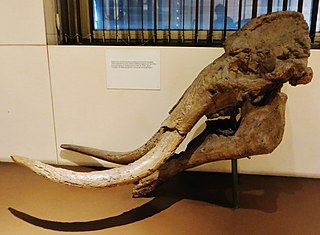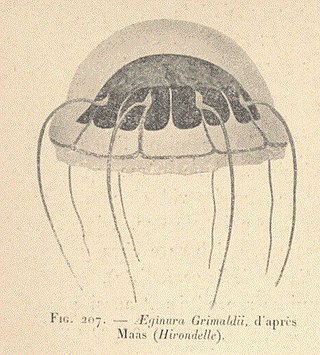
Cnidaria is a phylum under kingdom Animalia containing over 11,000 species of aquatic animals found both in freshwater and marine environments, predominantly the latter.

Hydrozoa is a taxonomic class of individually very small, predatory animals, some solitary and some colonial, most of which inhabit saline water. The colonies of the colonial species can be large, and in some cases the specialized individual animals cannot survive outside the colony. A few genera within this class live in freshwater habitats. Hydrozoans are related to jellyfish and corals and belong to the phylum Cnidaria.

Velella is a monospecific genus of hydrozoa in the Porpitidae family. Its only known species is Velella velella, a cosmopolitan free-floating hydrozoan that lives on the surface of the open ocean. It is commonly known by the names sea raft, by-the-wind sailor, purple sail, little sail, or simply Velella.

Medusozoa is a clade in the phylum Cnidaria, and is often considered a subphylum. It includes the classes Hydrozoa, Scyphozoa, Staurozoa and Cubozoa, and possibly the parasitic Polypodiozoa. Medusozoans are distinguished by having a medusa stage in their often complex life cycle, a medusa typically being an umbrella-shaped body with stinging tentacles around the edge. With the exception of some Hydrozoa, all are called jellyfish in their free-swimming medusa phase.
Paleontology or palaeontology is the study of prehistoric life forms on Earth through the examination of plant and animal fossils. This includes the study of body fossils, tracks (ichnites), burrows, cast-off parts, fossilised feces (coprolites), palynomorphs and chemical residues. Because humans have encountered fossils for millennia, paleontology has a long history both before and after becoming formalized as a science. This article records significant discoveries and events related to paleontology that occurred or were published in the year 1909.

Hydroidolina is a subclass of Hydrozoa and makes up 90% of the class. Controversy surrounds who the sister groups of Hydroidolina are, but research has shown that three orders remain consistent as direct relatives: Siphonophorae, Anthoathecata, and Leptothecata.

Leptothecata, or thecate hydroids, are an order of hydrozoans in the phylum Cnidaria. Their closest living relatives are the athecate hydroids, which are similar enough to have always been considered closely related, and the very apomorphic Siphonophorae, which were placed outside the "Hydroida". Given that there are no firm rules for synonymy for high-ranked taxa, alternative names like Leptomedusa, Thecaphora or Thecata, with or without the ending emended to "-ae", are also often used for Leptothecata.

Plumularioidea is a superfamily of hydrozoans in the order Leptothecata.

Ludwig Hans Fischer was an Austrian landscape painter, copper engraver, etcher and ethnologist. He was noted for his paintings of Oriental subjects, especially African and Indian women wearing traditional costume.
Aphomia curvicostellus is a species of snout moth in the genus Aphomia. It was described by Zerny, in 1914, and is known from Kazakhstan.

Acraea buettneri, the Buettner's acraea, is a butterfly in the family Nymphalidae. It is found in the Democratic Republic of the Congo, Angola and Zambia.

Eudendrium is a large genus of hydroids (Hydrozoa), one of two in the family Eudendriidae. These animals are marine cnidarias in the family Eudendriidae.

Choerolophodon is an extinct genus of proboscidean that lived during the Miocene of Eurasia and Africa. Fossils of Choerolophodon have been found in Africa, Southeast Europe, Turkey, Iraq, Iran, the Indian subcontinent, and China.

Halopterididae is a family of hydrozoans.

Aglaopheniidae is a family of hydrozoans.

Aglaophenia is a genus of hydrozoans in the family Aglaopheniidae.
Jean Bouillon was a Belgian marine biologist and expert on Hydrozoa.

Acryptolaria is a genus of hydrozoans in the family Lafoeidae.

Aeginura grimaldii is a species of deep sea hydrozoan of the family Aeginidae. It is found in the north-eastern Atlantic Ocean, Pacific Ocean, and the Arctic Ocean. It has a depth range of 660-1200m deep. Live specimens are bright reddish in color, with pale tentacles, and a light red globous capsule dome containing the dark colored red body. It usually measures no more than 4.5cm from the peak of the bell to the end of the tentacles.
Halisiphonia is a genus of deep water hydrozoans belonging to the family Hebellidae. There is little known about individual species. This lack of information has resulted from the difficulty of studying members of this genus due to the great depths at which they are located.














